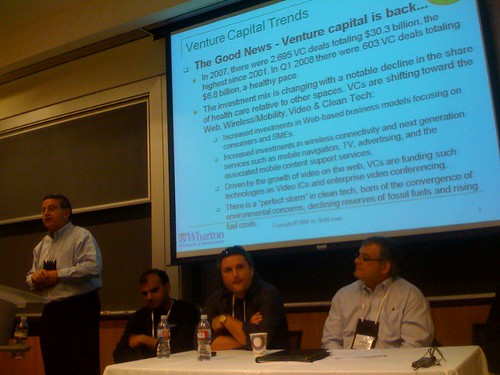Brave New World of Entrepreneurship and Venture Finance: New Realities, New Choices
Moderator
Raffi Amit (Wharton), Jeff Clavier (SoftTech VC), Jim Lussier (Norwest
Venture Partners), Evan Williams (Twitter), Vipin Jain (Retrevo), Jim
Greer (Kongregate)
"The startup financing process is changing. Companies today can start
anywhere, develop rapidly, and collaborate across multiple locations,
all for a fraction of what it used to cost. Angels, venture
capitalists, strategic investors, and entrepreneurs all face a new set
of choices. This session, moderated by one of the country’s leading
professors of entrepreneurship, will look at trends and changes in
funding strategies, deal structures, partnerships, and exit options,
and will feature experts from the key constituencies at the forefront
of these trends."
Raffi Amit began the panel with an overview of the current venture environment for startups. It’s a mix of good news (2007 had over 2,800 transactions) and bad (average time to exit via IPO or acquisition continues to extend).
Business models "span industry and firm boundaries" — Priceline.com didn’t invent a new technology, for example, but instead built a business aournd a novel business model.
Amit says the business models must be "NICE" and contain
- Novelty
- Lock-In
- Complements
- Efficiency
A link to details on the NICE model is here.
Ev: "Angel money helps you build an engine for your company, VC money is the fuel you put in the engine."
Jain: "I found a [VC] partner who resonated, who gave us money early to build the product."
Q: what’s the tradeoff between VC and Angel investors?
Greer: "The advantage of an angel is that you’re talking to a person, rather than someone representing limited partners (like at a VC firm). They have been in your shoes."
Lussier: "One of the things we’re seeing is a consolidation in the VC business now. The same amount is being invested, but it’s being concentrated in fewer hands. Right now, the venture industry is returning about 1x. Right now, there’s a "120/10" rule, not an "80/20" rule — 120% of the returns are going to come from 10% of the funds or 10% of the investments. As Series A investor, we’re looking to put 3MM-6MM-10MM into a round, and split that with another firm."
Clavier: "When to call whom: if you have a track record in the VC industry, you can go directly to VCs and don’t need to go to an angel syndicate. For angels, we look at valuation…’this company should be worth X.’ The valuation will be more flexible for the VCs. For angels, we look for a ‘good team.’ I take risky bets, but the ones that work will take care of the others."
Jain: "For very early stage, it’s important to find an individual who can emotionally attach to the prospects the company has."
Amit: Classes of risk:
- Company – Team, product
- Market – Willingness of buyers to buy, time to commoditization
- Capital – Ability to raise capital
Comment from Axel Schmiegelow: "If you get corporate VCs, get two (Clavier adds "get three") – it keeps them all on track."
Q: "How much runway should you have for your cash?"
Clavier: I like to see 12 months of solid execution from the cash we put in, plus time for fund raising. If the investment doesn’t cover 15-16 months of runway, it should. You want to have enough runway to know at the end of the tunnel if you can make it as a standalone company.
Jain: You should be raising enough money to last 18 months. Don’t worry about small (5%-10%) dilution to your stake. If you are confident you’ll hit the milestones from the business model or revenue model.
Lussier: Give yourself at least 18 months…you sometimes (always?) hit a bump.
Ev: No matter how much you’ll raise, you’ll always spend it in 12 months. (laughter)
#supernova2008
